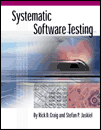
Systematic Software Testing
Published:
2002
Pages:
536
Upcoming Events
| Apr 27 |
STAREAST Software Testing Conference in Orlando & Online |
| Jun 08 |
AI Con USA An Intelligence-Driven Future |
| Sep 21 |
STARWEST Software Testing Conference in Anaheim & Online |



User Comments
As a leader of newly founded testing team I found this book great help with creating testing processes that didn't previously exist. Examples are good, and templates very usefull. Case studies make the book easier and lively to read - not that it's difficult to read to begin with. I would recommend this book to not only testers and test managers but also to non-technical people who want to understand and deal with testers.
excellent reference and a gude for testing people ,
it is valuable one
At last I have found a book that demonstrates a real understanding of software testing. It should be used as a good basic reference to all of the key issues and ideas in software testing.
As someone who runs his own training business, I found this book extremely useful. It was fun to read and it enabled me to illustrate many of the theoretical concepts in my ISEB foundation course with some practical examples. The IEEE test plan example at the end of the book was especially helpful to show the delegates a real example.
The overall structure of the book is excellent and it appears to be arranged to reflect the overall sequence of good testing practices, starting for example with a section that shows how to do a risk analysis with a clear and well thought out example.
As a good tester myself, I tried to “catch out” the authors by looking for areas that had not been addressed. It was difficult, however, to find topics on testing that had not been considered. It seems comprehensive enough to me and although there are areas of detail that could be expanded (e.g., white box techniques, reviews, risk management), in my opinion it is a “must read” first book for people new to software testing.
For experienced test consultants, new topics such as XP and exploratory testing, which are mentioned and the STEP methodology, would be of interest. The practical examples and key points contain a wealth of information and experience. Please use this to coach the junior members of your team and introduce them to best practices.
I appreciated the section discussing the value of certification of software testers.
The overall style of the book is great. It felt to me as if the authors were not above you, nor beneath you, but with you all the time. I suggest that you try to extract those principles and ideas that apply to your organisation and improve the effectiveness of your testing in a systematic way. This book makes an excellent guide.
This book is written for the software tester and/or test manager, and lives up to its title. The book explains how to go about planning a testing effort from a top-down perspective, discussing how to put together a master test plan (Chapter 3), and then drilling down into the nitty-gritty details (Chapter 4). Chapters 5 (Analysis & Design) describes some common testing techniques, which while not as comprehensive as some other s/w testing books, is perhaps unequaled in it's readability (Kudos to the copy-editor).
I like Chapters 6 (Test Implementation) and 7 (Test Execution) because they make for a good checklist for the tasks that need to be done to support the test execution phase, again what strikes me most about this book is the easy read, something especially useful when covering such potentially dry subject matter as "test status reporting".
Chapters 8 (Test Organization), 9 (The s/w Tester), and 10 (the Test Manager) touch upon the "soft issues" related to these roles - discussing such items as "the cornerstones of leadership", "career paths", and "how to hire testers". Finally, Chapter 11 discusses how to improve the testing process - no matter where on a "maturity" chart your organization resides.
One thing I did find interesting, was the prominence Risk & Stefan attached to using Risk as a means of guiding the entire testing effort (a mentality I personally concur with), this is evident in their decision to discuss this aspect of testing right up front in Chapter 2, and continually referring to it throughout the rest of the book.
In summary, I think Rick & Stefan have done a fantastic job of describing a systematic approach to software testing.
In the vain of "full disclosure", you should know that I've known Rick & Stefan for many years, and consequently I cannot be considered a completely impartial reviewer.
Steve Splaine.